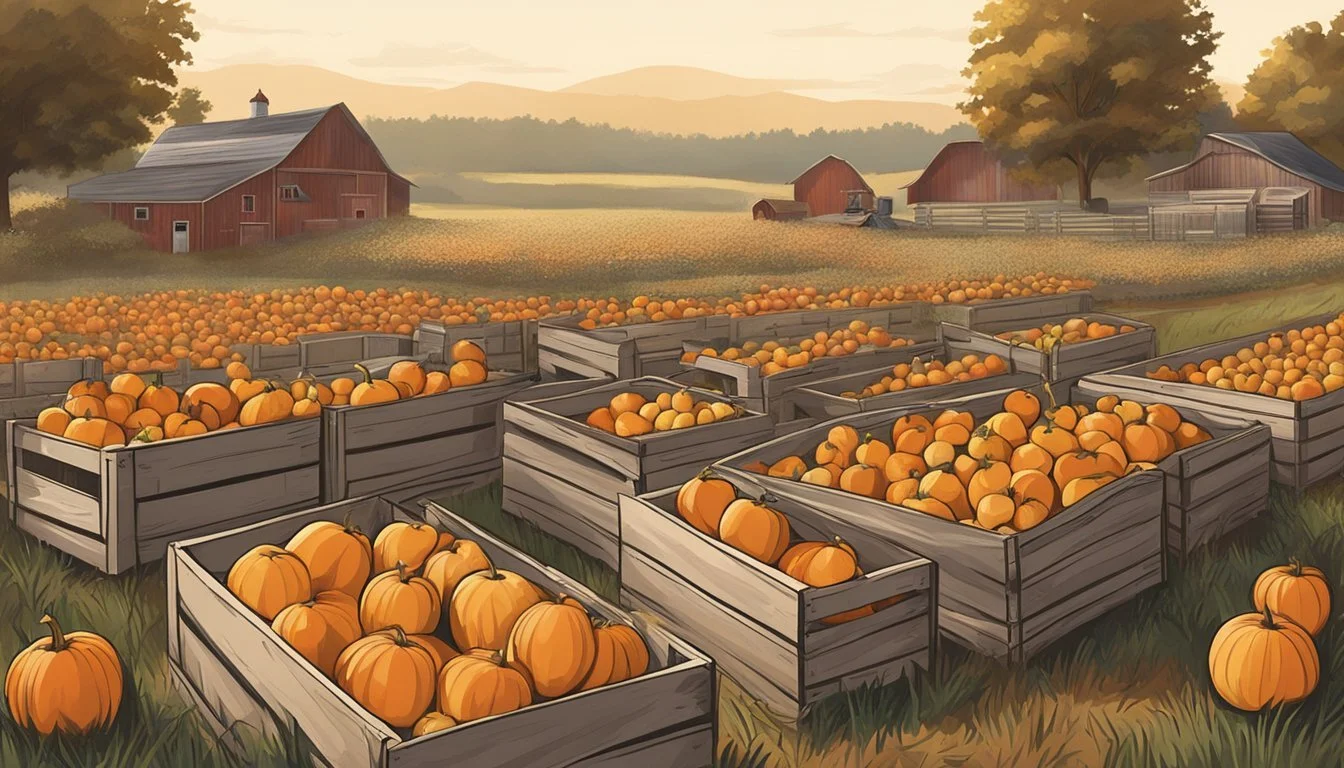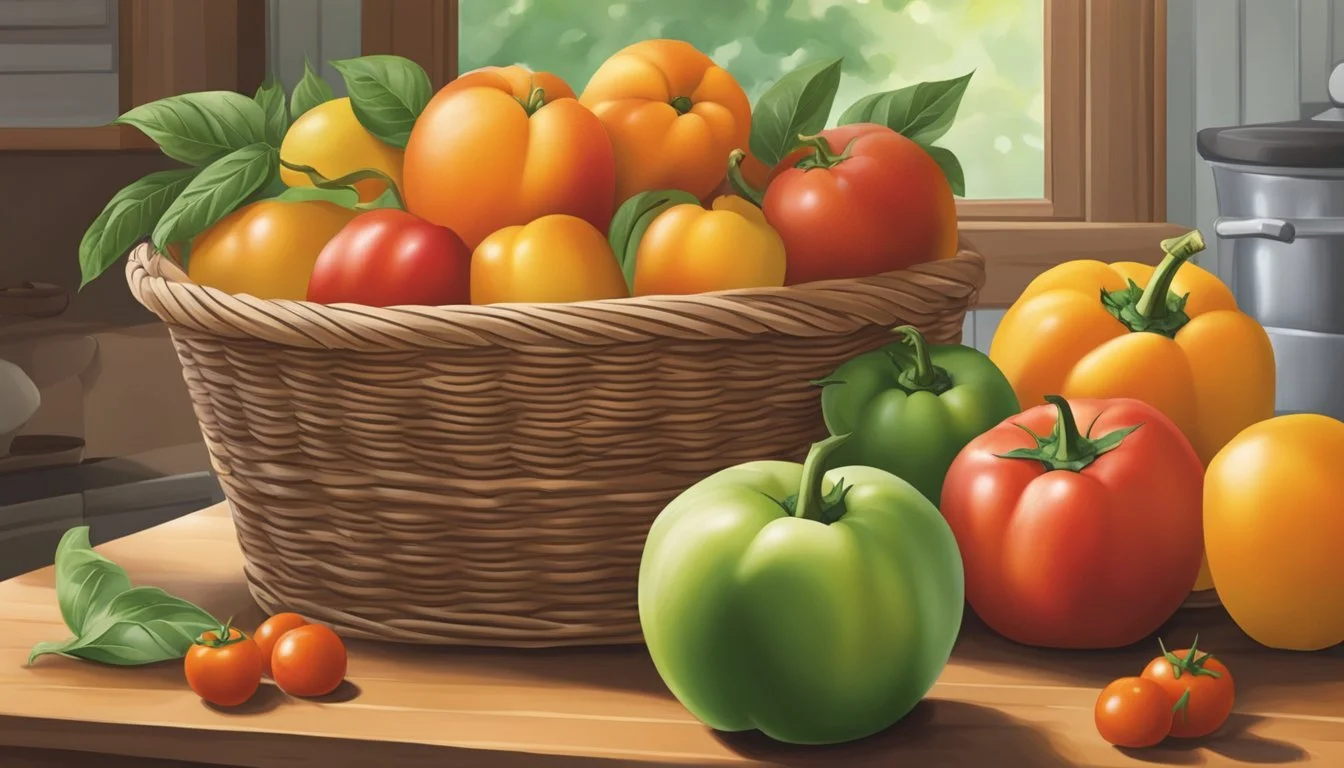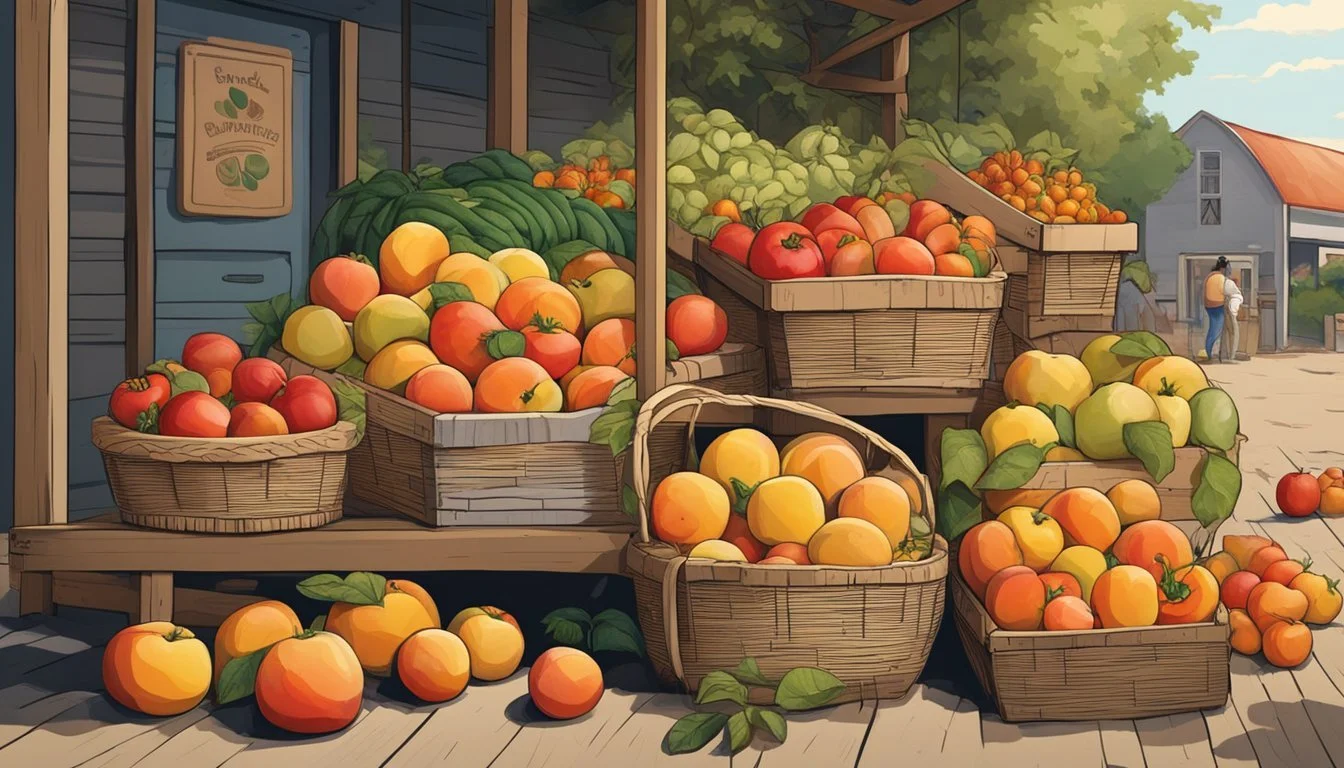North Carolina Seasonal Fruit & Vegetables in September
Your Fresh Produce Guide
This Article is Part of our North Carolina Seasonal Fruit & Veg Calendar
As the warmth of summer begins to wane, September ushers in a fruitful period for seasonal produce in North Carolina. The month's temperate climate supports a unique variety of fruits and vegetables ripe for harvest. Locally sourced produce not only embodies fresher flavors but also champions sustainability and bolsters the state's agricultural economy.
Fruits such as peaches are nearing the end of their season, offering a last chance to enjoy their juicy sweetness until next year. Meanwhile, vegetables like celery and a range of chili peppers are at their prime, bringing a crispness and heat to the table that can enhance any dish. The diversity of North Carolina's harvest in September affords both culinary creativity and nutritional richness, with seasonal selections offering an abundance of vitamins and minerals.
Incorporating seasonal fruits and vegetables into a diet during their peak harvest months ensures the highest quality in taste and nutrition. North Carolina's September yield, from the earthy firmness of root vegetables to the delicate flesh of late-summer fruits, provides consumers with a broad palette of flavors and textures to explore. This alignment with the harvest cycle not only promotes more flavorful meals but also supports the state's local farmers and reduces the environmental impact of long-distance transportation.
The Importance of Seasonality
Seasonality in produce refers to the times of year when fruits and vegetables are at their peak in flavor and nutrition. In North Carolina, September marks a time when consumers can enjoy a variety of fresh produce that is both healthful and supportive of the local economy.
Benefits of Eating Seasonal Produce
When individuals choose to eat fruits and vegetables that are in season, they are opting for produce that is likely to be fresher, more nutritious, and more flavorful. Seasonal fruits and vegetables tend not to undergo long storage periods or extensive travel, which often results in higher nutrient content. Consumers can enjoy health benefits from fresh produce that contains more vitamins and minerals compared to their out-of-season or stored counterparts.
Impact on North Carolina Agriculture
For North Carolina's agriculture, seasonality drives the local economy by supporting farms through the sale of fresh and locally grown produce. When consumers purchase seasonal items, they are investing in the local economy, which in turn can support the sustainability and growth of the farms. The sale of in-season fruits and vegetables often comes with reduced transportation and storage costs, making it a more economically viable option for both producers and consumers. Moreover, seasonal marketing can lead to diversification and an increase in crop resilience, contributing to a robust agricultural sector within the state.
September's Seasonal Fruits in North Carolina
September in North Carolina marks the transition from summer to autumn, offering a vibrant assortment of fruits at their peak, with apples (how long do apples last?), grapes, and melons being especially noteworthy.
Apple Varieties and Selection
North Carolina grows a rich variety of apples, with some of the most popular including 'Honeycrisp', 'Gala', 'Golden Delicious', and 'Fuji'. Consumers should look for firm, brightly colored apples with a fresh aroma, which indicate freshness and ripeness. The state's cool nights and warm days towards the latter months create ideal conditions for apple harvesting.
Common Apple Varieties:
'Honeycrisp'
'Gala'
'Red Delicious'
'Fuji'
Peak Harvest for Grapes
In September, vineyards across North Carolina reach the peak period for grape harvesting. This includes the deep-purple muscadine grapes, which are native to the Southeast and thrive in the state's soil and climate. The grape varietals hold a large role in both table consumption and local winemaking.
Grape Varieties in Season:
Muscadine
Scuppernong (a type of muscadine)
Availability of Melons
This month also heralds the end of the season for various melons, including watermelons and cantaloupes (how long does cantaloupe last?). They are widely available at local farmers' markets, and their freshness can be determined by a uniform shape, a dull rind for watermelons, and a fragrant aroma at the stem end for cantaloupes. These melons are not only refreshing but are also among the favorites due to their sweet flavor profiles and hydrating properties.
Melon Types Best in September:
Watermelon
Cantaloupe
September's Seasonal Vegetables in North Carolina
In September, North Carolina's gardens abound with a variety of vegetables reaching their peak. Shoppers can find an array of vibrant root vegetables and greens, as well as the last bounty of summer's harvest.
Root Vegetables and Greens
This month is ideal for savoring nutrient-rich root vegetables and hardy greens. Broccoli, known for its high vitamin content and anti-inflammatory benefits, thrives in the September cool. Shoppers should also look for:
Cabbage: Versatile in dishes, from slaws to stews.
Carrots: Perfect for a crunchy, nutritious snack or a sweet addition to meals.
Kale: Loaded with vitamins K, A, and C, enjoy it raw in salads or sautéed as a side.
Spinach: Tender and full of iron, it's a great base for salads or a healthful addition to smoothies.
Late Summer Harvests
While the air hints at the coming fall, late summer crops still offer a final taste of warmth. Notable mentions include:
Sweet Potatoes: A North Carolina specialty, these are just beginning their season, ripe for roasting or making into pies.
They represent the state's versatility in producing a range of fresh, flavorful vegetables that are perfect for a September table.
Harvesting and Storing Tips
In North Carolina, September brings an abundance of fresh produce to harvest. The key to prolonging the freshness and taste of this produce is using the correct techniques for harvesting and storing. Understanding these methods ensures both food safety and quality preservation.
Proper Technique for Fruit
When harvesting fruit, one must ensure they are picking at the peak of ripeness. Fruit should be gently twisted or snipped from the plant to avoid damage. For example:
Peaches: Should come off easily with a slight twist when ripe.
Apples: Twist upwards and outwards; they should detach easily when ready.
After harvesting, fruits like peaches and apples should be stored:
At room temperature until ripe.
In the refrigerator to slow down ripening once at peak.
Vegetable Storage Solutions
For vegetables, the key to storage is controlling temperature and humidity:
Sweet corn: Refrigerate immediately, storing in husks for maximum freshness.
Okra and cucumbers: Store in the refrigerator crisper drawer in perforated plastic bags.
For long-term preservation methods such as freezing or canning, it's crucial to follow food safety guidelines to prevent spoilage and foodborne illnesses. Vegetables should be:
Cleaned thoroughly.
Blanched if frozen, to preserve texture and color.
Canned using proper sterilization techniques for safety.
Proper storage solutions not only extend the shelf life of North Carolina's September harvest but also maintain the nutritional value and taste of the produce.
Farmers' Markets and Local Farms
In September, North Carolina's farmers' markets and local farms abound with fresh, in-season produce. Consumers seeking the freshest fruits and vegetables find these venues ideal, given their direct link to the agricultural richness of the state.
Finding the Best Markets
Visitors can discover a variety of farmers' markets spread throughout North Carolina. The state boasts a strong number of farmers' markets, each presenting a unique array of seasonal produce. Key markets include the State Farmers Market in Raleigh, which is renowned for its wide selection, and smaller local markets such as the Carrboro Farmers' Market, which offers an intimate setting with goods sourced exclusively from local farms.
To ensure the best experience, shoppers should:
Check market schedules, as some may be seasonal or have specific operating hours.
Look for markets with a vendor policy requiring produce to be locally grown, ensuring that purchases support local agriculture and provide the freshest options.
Supporting Local Farms
Engaging with local farms by purchasing their produce at farmers' markets helps sustain the state's agricultural base and contributes to the local economy. When consumers buy directly from farmers, they:
Guarantee Fresher Produce: Local produce often goes from farm to market rapidly, ensuring peak freshness and flavor.
Advance Sustainable Practices: Supports farms which often use sustainable methods that benefit the local environment.
Foster Community Connections: Creates a direct line of communication between consumers and growers.
Local farms in North Carolina are recognized for their quality and variety of fruits and vegetables, with September marking the peak time for many crops. By frequenting these markets and farms, individuals directly influence the state's agricultural success and maintain North Carolina's reputation for fresh, locally-sourced food.
Preparing Seasonal Dishes
September in North Carolina offers a variety of fresh produce perfect for creating vibrant and nutritious dishes. Utilizing these seasonal offerings not only enhances flavor but supports local agriculture.
Simple Recipes for September Produce
Peach Cobbler: Capitalize on the sweetness of September's ripe peaches by baking a classic peach cobbler.
Ingredients: fresh peaches, sugar, flour, butter, and cinnamon.
Tip: For best results, peel the peaches and let them macerate with sugar to draw out their natural juices before baking.
Sweet Corn Salad: She can toss together a refreshing salad using just-picked sweet corn.
Ingredients: sweet corn, cherry tomatoes, cucumber, fresh basil, olive oil, and lemon juice.
Cooking tip: Grill the corn briefly for a smoky flavor before slicing it off the cob.
Canning and Preserving Harvest
Blueberry Jam: With September's blueberries at their peak, she can make homemade jam that captures the essence of the fruit.
Ingredients: blueberries, sugar, and pectin (how long does pectin last?).
Tip: To ensure a good set, use a candy thermometer to bring the mixture to the proper temperature.
Pickled Okra: Preserving okra by pickling allows her to enjoy its distinct flavor year-round.
Ingredients: okra, vinegar, salt, dill, and garlic.
Preserving tip: Sterilize jars properly to ensure the pickled okra lasts through the seasons.
By taking advantage of North Carolina's September produce, anyone can prepare and preserve the flavors of the season with these simple yet satisfying recipes.
Community Events and Festivals
Throughout September, North Carolina buzzes with local events and festivals celebrating the bounty of the season. One such gathering is the N.C. Apple Festival in Hendersonville. This event lasts four days and honors the local apple harvest with a street fair, fresh apples, arts and crafts, and free entertainment set against the backdrop of the Historic Courthouse on Main Street.
In addition, the North Carolina Watermelon Festival in Murfreesboro is not to be missed. This annual event spans four days and features amusement park rides, watermelon-themed contests, and performances by local bands. It provides a space for community engagement through the celebration of one of the state's favorite fruits.
Patrons can expect to find festivals like these brimming with local produce and opportunities to interact with North Carolinian farmers, showcasing the state’s emphasis on community and agricultural traditions. These events serve as a hub for community engagement, allowing people to connect with the sources of their food.
Attendees can thoroughly immerse themselves in the local culture through these events, gaining insight into North Carolina's agricultural practices and seasonal offerings. It's a perfect occasion to indulge in fresh, seasonally available produce while enjoying the state's vibrant community spirit.
Promoting Seasonal Produce
In September, North Carolina's harvest brings forth a bounty of fresh, localized fruits and vegetables. Educating the public and utilizing targeted social media campaigns can significantly enhance consumer awareness and consumption of these seasonal offerings.
Educational Programs
Educational initiatives play a crucial role in promoting seasonal produce. They focus on informing consumers about the benefits of purchasing fruits and vegetables that are in peak season. For example, extension services and local agricultural organizations often host workshops and farm tours in September to educate on the seasonal availability of items like apples, eggplant, and pumpkins. These programs underscore the richness of taste and nutritional value found in freshly harvested produce.
Workshops and Seminars: Covering seasonal recipes, preservation techniques, and nutritional information.
Farm Tours: Offering firsthand experience of the harvesting process and direct interaction with farmers.
Social Media Campaigns
Social media platforms are powerful tools for promoting seasonal fruits and vegetables. They leverage their widespread reach to increase awareness and educate consumers on what is currently in season.
Facebook and Twitter: Utilize regular posts and updates about the seasonal produce available, often featuring vivid imagery and engaging content that encourages sharing and interaction.
Facebook: Posts may include farmer interviews, recipe videos, and live Q&A sessions.
Twitter: Quick tips, produce facts, and hashtags such as #NCInSeason to track the conversation.
Pinterest: Ideal for sharing visually appealing content, such as infographics on seasonal fruits and vegetables, and links to recipes that showcase September's harvest.
By focusing on educational programs and social media campaigns, there's a clear path to boosting consumer awareness and appreciation for North Carolina's September produce.
Environmental Considerations
September in North Carolina marks a transitional period where the state's agriculture moves from the warmth-loving summer crops to those that can thrive in the cooler temperatures of fall. During this month, sustainable farming practices come to the forefront as they play a significant role in minimizing the environmental footprint. Farmers often rotate their crops to maintain soil health and reduce the need for chemical fertilizers.
Seasonal impact is another aspect that greatly influences farming practices. By growing fruits and vegetables that are suited to the current climate and soil conditions, farmers can use less water and fewer resources. This not only ensures a bountiful harvest but also reduces the strain on the local environment.
A table highlighting some of the seasonal produce available in September is presented below:
Fruits Vegetables Apples Bell peppers Pears Radishes Muscadine grapes -
The environmental footprint of farming includes the energy used in production, transportation, and storage of food. By choosing locally grown, seasonal produce, consumers can help lower this footprint. Local produce is fresher, travels shorter distances, and, as a result, contributes to reduced greenhouse gas emissions.
Farmers and consumers alike are encouraged to consider these environmental factors. They shape not only the current landscape of agriculture but also have long-lasting effects on the overall health of the ecosystem. By adhering to sustainable practices and making informed choices, the relationship with the land can be nurtured for future generations.










